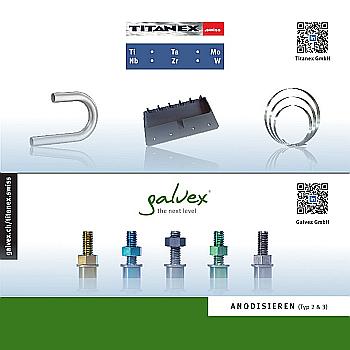Titanex @ MedtechLive 24 Stuttgart
Stay competitive! Through Delivery Time, Quantity and Price!
Download
Anfrage / Bedarf
Steigern Sie Ihre Wettbewerbsfähigkeit! Durch Lieferzeit, Menge und Preis!
Titanex' Lagerlisten holen!

Meet us 18th - 20th June @ MedtechLive Stuttgart
» Fabrication Aerospace
The technology of fabricating titanium has evolved from simple conventional processes to highly sophisticated techniques. A wide range of capabilities are now available. End application specifications and economics should determine the process selected. In order to optimize fabrication, considerations must be given to the grade or alloy, heat treatment and crystal structure.
Although titanium is readily fabricable, some general differences from other structural metals should be recognized:
- lower modulus of elasticity,
- higher melting point,
- lower ductility,
- propensity to gall and
- sensitivity to contamination in air at welding temperatures.
Titanium can usually becold worked on equipment designed for stainless steel. Press brakes used for forming sheet, shears, cold rolls, hydro press forming, drawing and pilgering can all be used. The majority of aircraft and some industrial components require hot working to overcome springback, minimize stresses and to reduce the high forming forces needed for titanium alloys.
Casting, forging, hot forming and other elevated temperature processes, play an important roll in providing shapes with desired properties and maximum metal utilization. Forgings are the workhorse of the aerospace industry with a wide range of sizes available. New developments in precision forgings now provide near net shapes with improved material efficiencies. Both investment and sand or graphite mold castings are used and have increased significantly with the use of hot isostatic pressing (HlP'ing) to seal internal voids and improve properties.
Extrusions and hot rolling are used to produce shapes. Hot forming of sheet and plate is extensively used for aircraft components. Superplastic forming under pressure and temperature has recently found growing acceptance. Diffusion bonding is often incorporated in the same process.
Welding requires adherence to rules of cleanliness and exclusion of reactive gases including air. Welding by means of the TIG process (Tungsten Electrode Inert Gas) using argon gas shielding is most commonly used. Plasma, laser, resistance, electron beam, MIG, and welding friction all have their place. Techniques are available to weld titanium under a wide range of conditions both in the shop and in the field.
Cladding is being performed by a range of processes primarily for industrial equipment. Explosive bonding and mechanical fastened loose lining have been used for years. More recently roll cladding, resistance weld lining and diffusion bonding are being applied.
Machining by all of the customary methods is being done. Some preferred procedures are recommended such as sharp tools, rigid set-ups, heavy feeds, slow speeds and an abundance of soluble coolant. Work hardening rate is less than that for stainless steels. Drilling and cold saw cutting require sharp, clean tools with good chip removal and ample coolant.
Torchcutting with oxyacetylene flame can be accomplished in sections up to 6" thick. Care must be taken to remove all surface contaminant. Hard wheel abrasive grinding, using clean wheels with large grains can be used to clean cut edges without alpha phase contamination as excessive heat build-up is avoided.
» Fabrication Attention:
Above 400 °C the chemical Elements N-O-C-H will get into the metallic structure and increase risk of intercristalline cracking!






